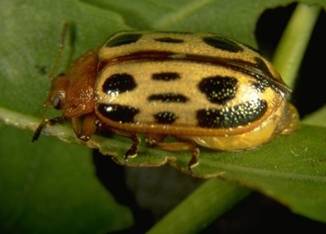Cottonwood leaf beetle
Natural History

Adult Cottonwood Leaf Beetle
Photo credit: Bart Drees, Extension Entomology, TAMU
The cottonwood leaf beetle is one of the most destructive insect pests of poplars and willows in the southeastern United States. The insect can cause serious defoliation and injury to young plantations, nurseries and ornamental trees. Seriously defoliated trees are weakened and predisposed to injury by other insects (such as borers) and various pathogens. In biomass plantings, volume can be seriously reduced by repeated injury by the cottonwood leaf beetle. Damage is often most severe in newly established plantings and in nurseries.
Damage begins in early spring when adults emerge from under fallen leaves and weeds and begin feeding on new foliage. Adults mate and yellow, oval egg clusters of 25 or more are laid on leaf surfaces (usually undersides). Larvae hatch and begin feeding on the same leaf. Larve mature into pupate by attaching to plant surfaces and remaining stationary. Pupation usually takes 5-10 days and mature beetles emerge and complete the cycle. There can be multiple generations (up to 7 or more in the South). Usually, all life stages can be seen at one time. Management for cottonwood leaf beetle includes resistance, chemical control and pruning of damaged shoots.
